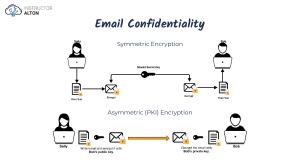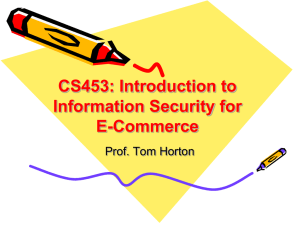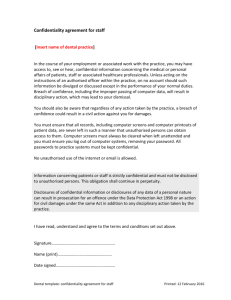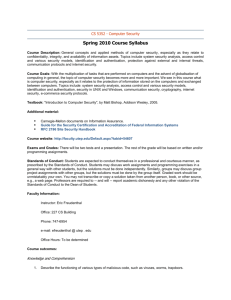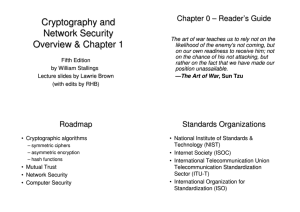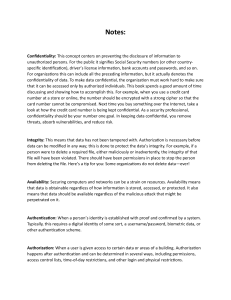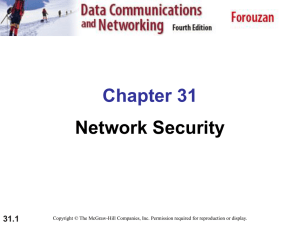Computer Security
advertisement
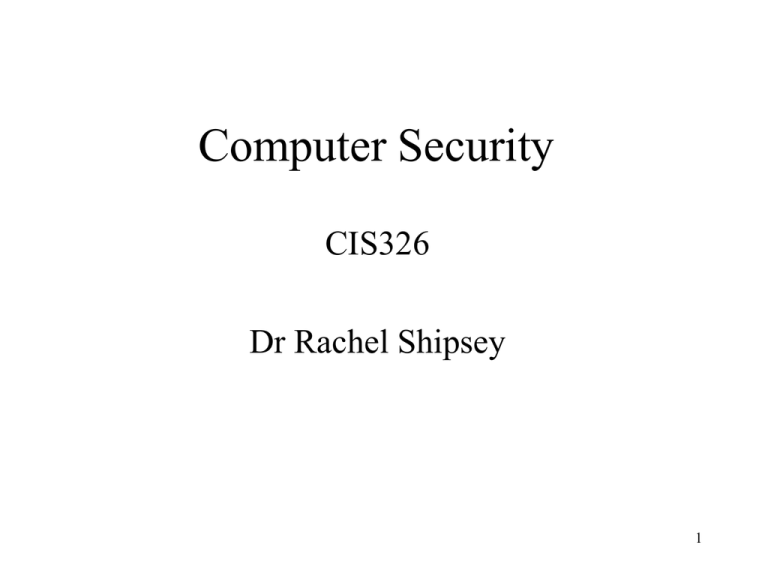
Computer Security CIS326 Dr Rachel Shipsey 1 This course will cover the following topics: • • • • • • • passwords access controls symmetric and asymmetric encryption confidentiality authentication and certification security for electronic mail key management 2 The following books are recommended as additional reading to the CIS326 study guide • • • • • Computer Security by Dieter Gollman Secrets and Lies by Bruce Schneier Security in Computing by Charles Pfleeger Network Security Essentials by William Stallings Cryptography - A Very Short Introduction by Fred Piper and Sean Murphy • Practical Cryptography by Niels Ferguson and Bruce Schneier 3 There are also many websites dealing with the subjects discussed in this course. For example, the following website provides links to a large number of sites who have security and cryptography course on-line: http://avirubin.com/courses.html 4 What is Security? Security is the protection of assets. The three main aspects are: • prevention • detection • re-action 5 Some differences between traditional security and information security • Information can be stolen - but you still have it • Confidential information may be copied and sold - but the theft might not be detected • The criminals may be on the other side of the world 6 Computer Security deals with the prevention and detection of unauthorised actions by users of a computer system. 7 There is no single definition of security What features should a computer security system provide? 8 Confidentiality • The prevention of unauthorised disclosure of information. • Confidentiality is keeping information secret or private. • Confidentiality might be important for military, business or personal reasons. 9 Integrity • Integrity is the unauthorised writing or modification of information. • Integrity means that there is an external consistency in the system - everything is as it is expected to be. • Data integrity means that the data stored on a computer is the same as the source documents. 10 Availability • Information should be accessible and useable upon appropriate demand by an authorised user. • Availability is the prevention of unauthorised withholding of information. • Denial of service attacks are a common form of attack. 11 Non-repudiation • Non-repudiation is the prevention of either the sender or the receiver denying a transmitted message. • A system must be able to prove that certain messages were sent and received. • Non-repudiation is often implemented by using digital signatures. 12 Authentication • Proving that you are who you say you are, where you say you are, at the time you say it is. • Authentication may be obtained by the provision of a password or a scan of your retina. 13 Access Controls • The limitation and control of access through identification and authentication. • A system needs to be able to indentify and authenticate users for access to data, applications and hardware. • In a large system there may be a complex structure determining which users and applications have access to which objects. 14 Accountability • The system managers are accountable to scrutiny from outside. • Audit trails must be selectively kept and protected so that actions affecting security can be traced back to the responsible party 15 Security systems • A security system is not just a computer package. It also requires security conscious personnel who respect the procedures and their role in the system. • Conversely, a good security system should not rely on personnel having security expertise. 16 Risk Analysis • The disadvantages of a security system are that they are time-consuming, costly, often clumsy, and impede management and smooth running of the organisation. • Risk analysis is the study of the cost of a particular system against the benefits of the system. 17 Designing a Security System There are a number of design considerations: • Does the system focus on the data, operations or the users of the system? • What level should the security system operate from? Should it be at the level of hardware, operating system or applications package? • Should it be simple or sophisticated? • In a distributed system, should the security be centralised or spread? • How do you secure the levels below the level of the security system? 18 Security Models A security model is a means for formally expressing the rules of the security policy in an abstract detached way. The model should be: • easy to comprehend • without ambiguities • possible to implement • a reflection of the policies of the organisation. 19 Summary By now you should have some idea about • Why we need computer security (prevention, detection and re-action) • What a computer security system does (confidentiality, integrity, availability, nonrepudiation, authentication, access control, accountability) • What computer security exerts do (design, implement and evaluate security systems) 20

